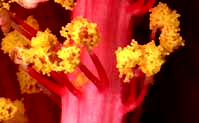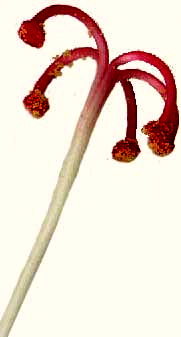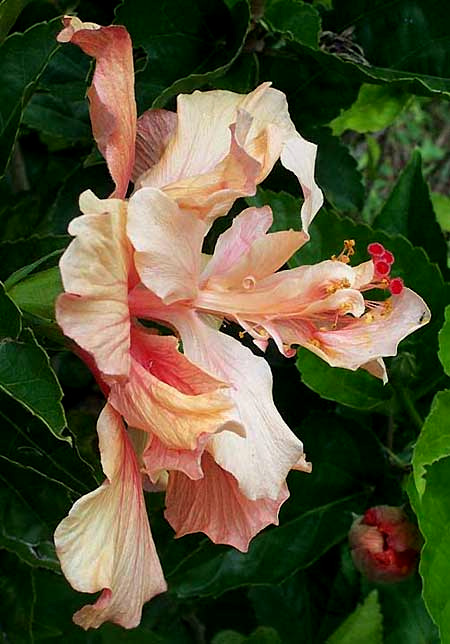 About 200 species of hibiscus are known to exist, and each species has its own unique kind of flower. However, all hibiscus flowers share certain features. The blossom at the right is fairly typical. That flower is from a plant in my garden, one known asHibiscus coccineus, a species native to the swamps of Georgia and Florida. The flower is shown at about its actual size. About 200 species of hibiscus are known to exist, and each species has its own unique kind of flower. However, all hibiscus flowers share certain features. The blossom at the right is fairly typical. That flower is from a plant in my garden, one known asHibiscus coccineus, a species native to the swamps of Georgia and Florida. The flower is shown at about its actual size.
At the top of the picture showing the staminal column notice how there are several recurved, red things looking So, if you find a flower with this particular arrangement of flower parts -- a staminal tube surrounding a long, slender style that's split into slender, spreading branches at the top -- you'll know you have an hibiscus flower! However, remember that plant breeders are always striving for bigger, more spectacular blossoms. Consider the following:
In this blossom of the Rose-of-China, Hibiscus rosa-sinensis, several stamens on the staminal column have developed into petals or "half-petal, half-stamen" appendages. Converting stamens to flashy petals is a trick plant breeders often employ to make blossoms gaudier. The same trick is used among roses -- wild roses have only five petals but you know that garden roses usually have more, thanks to this trick -- as well as buttercups, camellias and others. You can see a "half-petal, half-stamen" at the bottom of our Rose Page. Hibiscus flowers are among the prettiest, most interesting and easy-to-identify of all the Earth's blossoms. |


 If you tear away one side of the flower at the right, inside you'll find the item shown at the left. When you see what you see there, you know you have an hibiscus flower. Remembering from our
If you tear away one side of the flower at the right, inside you'll find the item shown at the left. When you see what you see there, you know you have an hibiscus flower. Remembering from our  "stamen tube." At the right you see a close-up of the staminal column showing how each stamen is attached to it.
"stamen tube." At the right you see a close-up of the staminal column showing how each stamen is attached to it. like very slender fingers with knobby tips poking through the stamens. If you carefully cut away one side of the staminal column you'll find that it is an empty cylinder, and that inside it is the long, slender styleshown in the much-magnified picture at the left. In the close-up at the left, notice how the style separates into five style-branches, and each style branch ends in a roundish stigma. That's what looks like recurved, slender fingers in the picture of the staminal column. In the picture at the left you can see individual pollen grains sticking to the stigma and style branches, and of course those pollen grains carry the male sex germ.
like very slender fingers with knobby tips poking through the stamens. If you carefully cut away one side of the staminal column you'll find that it is an empty cylinder, and that inside it is the long, slender styleshown in the much-magnified picture at the left. In the close-up at the left, notice how the style separates into five style-branches, and each style branch ends in a roundish stigma. That's what looks like recurved, slender fingers in the picture of the staminal column. In the picture at the left you can see individual pollen grains sticking to the stigma and style branches, and of course those pollen grains carry the male sex germ.
Thank you for educating us about hibiscus. They are truly beautiful flowers. I always smile when I see them because my father-in-law always called them "hi-biscuits."
ReplyDelete